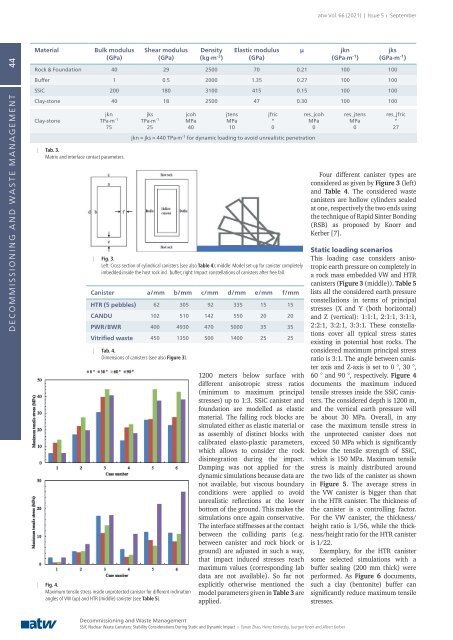atw - International Journal for Nuclear Power | 05.2021
Description Ever since its first issue in 1956, the atw – International Journal for Nuclear Power has been a publisher of specialist articles, background reports, interviews and news about developments and trends from all important sectors of nuclear energy, nuclear technology and the energy industry. Internationally current and competent, the professional journal atw is a valuable source of information. www.nucmag.com
Description
Ever since its first issue in 1956, the atw – International Journal for Nuclear Power has been a publisher of specialist articles, background reports, interviews and news about developments and trends from all important sectors of nuclear energy, nuclear technology and the energy industry. Internationally current and competent, the professional journal atw is a valuable source of information.
www.nucmag.com
Create successful ePaper yourself
Turn your PDF publications into a flip-book with our unique Google optimized e-Paper software.
<strong>atw</strong> Vol. 66 (2021) | Issue 5 ı September<br />
DECOMMISSIONING AND WASTE MANAGEMENT 44<br />
Material<br />
Bulk modulus<br />
(GPa)<br />
Shear modulus<br />
(GPa)<br />
Density<br />
(kg·m -3 )<br />
Elastic modulus<br />
(GPa)<br />
1200 meters below surface with<br />
different anisotropic stress ratios<br />
(minimum to maximum principal<br />
stresses) up to 1:3. SSiC canister and<br />
foundation are modelled as elastic<br />
material. The falling rock blocks are<br />
simulated either as elastic material or<br />
as assembly of distinct blocks with<br />
calibrated elasto-plastic parameters,<br />
which allows to consider the rock<br />
disintegration during the impact.<br />
Damping was not applied <strong>for</strong> the<br />
dynamic simulations because data are<br />
not available, but viscous boundary<br />
conditions were applied to avoid<br />
unrealistic reflections at the lower<br />
bottom of the ground. This makes the<br />
simulations once again conservative.<br />
The interface stiffnesses at the contact<br />
between the colliding parts (e.g.<br />
between canister and rock block or<br />
ground) are adjusted in such a way,<br />
that impact induced stresses reach<br />
maximum values (corresponding lab<br />
data are not available). So far not<br />
explicitly otherwise mentioned the<br />
model parameters given in Table 3 are<br />
applied.<br />
µ jkn<br />
(GPa·m -1 )<br />
jks<br />
(GPa·m -1 )<br />
Rock & Foundation 40 29 2500 70 0.21 100 100<br />
Buffer 1 0.5 2000 1.35 0.27 100 100<br />
SSiC 200 180 3100 415 0.15 100 100<br />
Clay-stone 40 18 2500 47 0.30 100 100<br />
Clay-stone<br />
jkn<br />
TPa·m -1<br />
75<br />
| Tab. 3.<br />
Matrix and interface contact parameters.<br />
jks<br />
TPa·m -1<br />
25<br />
jcoh<br />
MPa<br />
40<br />
jtens<br />
MPa<br />
10<br />
jfric<br />
°<br />
0<br />
res_jcoh<br />
MPa<br />
0<br />
jkn = jks = 440 TPa·m -1 <strong>for</strong> dynamic loading to avoid unrealistic penetration<br />
| Fig. 3.<br />
Left: Cross section of cylindrical canisters (see also Table 4); middle: Model set-up <strong>for</strong> canister completely<br />
imbedded inside the host rock incl. buffer; right: Impact constellations of canisters after free fall.<br />
Canister a/mm b/mm c/mm d/mm e/mm f/mm<br />
HTR (5 pebbles) 62 305 92 335 15 15<br />
CANDU 102 510 142 550 20 20<br />
PWR/BWR 400 4930 470 5000 35 35<br />
Vitrified waste 450 1350 500 1400 25 25<br />
| Tab. 4.<br />
Dimensions of canisters (see also Figure 3).<br />
| Fig. 4.<br />
Maximum tensile stress inside unprotected canister <strong>for</strong> different inclination<br />
angles of VW (up) and HTR (middle) canister (see Table 5).<br />
res_jtens<br />
MPa<br />
0<br />
res_jfric<br />
°<br />
27<br />
Four different canister types are<br />
considered as given by Figure 3 (left)<br />
and Table 4. The considered waste<br />
canisters are hollow cylinders sealed<br />
at one, respectively the two ends using<br />
the technique of Rapid Sinter Bonding<br />
(RSB) as proposed by Knorr and<br />
Kerber [7].<br />
Static loading scenarios<br />
This loading case considers anisotropic<br />
earth pressure on completely in<br />
a rock mass embedded VW and HTR<br />
canisters (Figure 3 (middle)). Table 5<br />
lists all the considered earth pressure<br />
constellations in terms of principal<br />
stresses (X and Y (both horizontal)<br />
and Z (vertical): 1:1:1, 2:1:1, 3:1:1,<br />
2:2:1, 3:2:1, 3:3:1. These constellations<br />
cover all typical stress states<br />
existing in potential host rocks. The<br />
considered maximum principal stress<br />
ratio is 3:1. The angle between canister<br />
axis and Z-axis is set to 0 °, 30 °,<br />
60 ° and 90 °, respectively. Figure 4<br />
documents the maximum induced<br />
tensile stresses inside the SSiC canisters.<br />
The considered depth is 1200 m,<br />
and the vertical earth pressure will<br />
be about 30 MPa. Overall, in any<br />
case the maximum tensile stress in<br />
the unprotected canister does not<br />
exceed 50 MPa which is significantly<br />
below the tensile strength of SSiC,<br />
which is 150 MPa. Maximum tensile<br />
stress is mainly distributed around<br />
the two lids of the canister as shown<br />
in Figure 5. The average stress in<br />
the VW canister is bigger than that<br />
in the HTR canister. The thickness of<br />
the canister is a controlling factor.<br />
For the VW canister, the thickness/<br />
height ratio is 1/56, while the thickness/height<br />
ratio <strong>for</strong> the HTR canister<br />
is 1/22.<br />
Exemplary, <strong>for</strong> the HTR canister<br />
some selected simulations with a<br />
buffer sealing (200 mm thick) were<br />
per<strong>for</strong>med. As Figure 6 documents,<br />
such a clay (bentonite) buffer can<br />
significantly reduce maximum tensile<br />
stresses.<br />
Decommissioning and Waste Management<br />
SSiC <strong>Nuclear</strong> Waste Canisters: Stability Considerations During Static and Dynamic Impact ı Yanan Zhao, Heinz Konietzky, Juergen Knorr and Albert Kerber

















